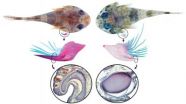(Press-News.org) COLUMBIA, Mo. – The 1918 Flu Pandemic infected over 500 million people, killing at least 50 million. Now, a researcher at the University of Missouri has analyzed the pandemic in two remote regions of North America, finding that despite their geographical divide, both regions had environmental, nutritional and economic factors that influenced morbidity during the pandemic. Findings from the research could help improve current health policies.
"Epidemics such as the Black Death in the 14th century, cholera in the 19th century and malaria have been documented and recorded throughout history," said Lisa Sattenspiel, professor of anthropology in the College of Arts and Science at MU. "While it is probably impossible to consider all the dimensions of pandemics, such as cultural, social and political factors, we can get a 'snapshot' by pinpointing similar areas. Our research focused on the 1918 influenza pandemic in Labrador, Canada and Alaska, which are widely separated in space, yet have similar geographic and environmental constraints as well as ethnic overlap."
By analyzing death records and community history, Sattenspiel and her fellow researcher, Svenn-Erik Mamelund, senior researcher at the Work Research Institute of Oslo, found that both Labrador and Alaska were devastated by the 1918 pandemic. Beginning in January 1918 and lasting through December 1920, both regions experienced higher mortality rates than most other parts of the world—34 percent and 8 percent, respectively.
Archival materials from Labrador and Alaska indicated that circulating pathogens, including pneumonia and tuberculosis, played a role in morbidity. Environmental influences, including harsh, stressful winters, and nutritional factors, such as lack of food, also played a role in susceptibility to influenza. Sattenspiel says that during the summer months in Labrador the influx of infected commercial fishermen played an important role in the milder first wave of the pandemic, while during the severe second (fall and winter) wave, the movements of fur traders and hunters were more important. Additionally, researchers found that transmission rates were higher in harsher climates where a greater proportion of daily life is conducted indoors.
"Inadequate access to health care contributed to higher mortality rates in the regions studied," Sattenspiel said. "Our findings indicate that today's infectious disease planning should include evaluating the placement of nurses and trained health care professionals who can administer vaccines and treatment. Programs that improve housing conditions and crowding may also help reduce disease transmission. Finally, contingency plans must take into account the remoteness of an area as well as distance to population centers and health care facilities."
Sattenspiel says that lessons learned from 20th century Labrador and Alaska illustrate how important it is to take a systemic approach if health officials are to improve our response to future infectious disease pandemics in today's world.
Her study, "Cocirculating epidemics, chronic health problems, and social conditions in early 20th century Labrador and Alaska," was published in the Annals of Anthropological Practice.
INFORMATION: END
Understanding the 1918 flu pandemic can aid in better infectious disease response
Research can be used to help inform current policies related to epidemic health issues
2014-05-14
ELSE PRESS RELEASES FROM THIS DATE:
Tiny, tenacious and tentatively toxic
2014-05-14
COLLEGE STATION – Sometimes we think we know everything about something only to find out we really don't, said a Texas A&M University scientist.
Dr. Kevin Conway, assistant professor and curator of fishes with Texas A&M's department of wildlife and fisheries sciences at College Station, has published a paper documenting a new species of clingfish and a startling new discovery in a second well-documented clingfish.
Smithsonian Institution
The paper, entitled "Cryptic Diversity and Venom Glands in Western Atlantic Clingfishes of the Genus Acyrtus (Teleostei: Gobiesocidae)," ...
Chapman University affiliated physicist publishes on the Aharonov-Bohm effect in Nature
2014-05-14
ORANGE, Calif. – Chapman University affiliated quantum physicist Yutaka Shikano, Ph.D., has published a milestone paper in the prestigious journal Nature Communications. The title of the article is "Aharonov-Bohm effect with quantum tunneling in linear Paul trap." The Aharonov-Bohm (AB) effect was proposed by Yakir Aharonov, who is the co-director of the Institute for Quantum Studies at Chapman University, and David J. Bohm in 1959.
The AB effect showed for the first time that a magnetic field inside a confined region can have a measureable impact on a charged particle ...
Simplifying an ultrafast laser offers better control
2014-05-14
This news release is available in French. Going back to the drawing board to find a way to overcome the technical limitations of their laser, a team led by François Légaré, professor at the INRS Énergie Matériaux Télécommunications Research Centre, developed a new concept offering a simpler laser design, control over new parameters, and excellent performance potential. Called "frequency domain optical parametric amplification" (FOPA), the concept supersedes traditional time domain amplification schemes that have been the linchpin of ultrafast laser science for 20 years. ...
Magnetar formation mystery solved?
2014-05-14
When a massive star collapses under its own gravity during a supernova explosion it forms either a neutron star or black hole. Magnetars are an unusual and very exotic form of neutron star. Like all of these strange objects they are tiny and extraordinarily dense — a teaspoon of neutron star material would have a mass of about a billion tonnes — but they also have extremely powerful magnetic fields. Magnetar surfaces release vast quantities of gamma rays when they undergo a sudden adjustment known as a starquake as a result of the huge stresses in their crusts.
The Westerlund ...
Microchip-like technology allows single-cell analysis
2014-05-14
VIDEO:
This is a microscopic view of the new microchip-like technology sorting and storing magnetic particles in a three-by-three array.
Click here for more information.
DURHAM, N.C. -- A U.S. and Korean research team has developed a chip-like device that could be scaled up to sort and store hundreds of thousands of individual living cells in a matter of minutes. The system is similar to a random access memory chip, but it moves cells rather than electrons.
Researchers at ...
Using nature as a model for low-friction bearings
2014-05-14
Lubricants are required wherever moving parts come together. They prevent direct contact between solid elements and ensure that gears, bearings, and valves work as smoothly as possible. Depending on the application, the ideal lubricant must meet conflicting requirements. On the one hand, it should be as thin as possible because this reduces friction. On the other hand, it should be viscous enough that the lubricant stays in the contact gap. In practice, grease and oils are often used because their viscosity increases with pressure.
Biological lubrication in contrast is ...
Early menopause ups heart failure risk, especially for smokers
2014-05-14
CLEVELAND, Ohio (May 14, 2014)—Women who go through menopause early—at ages 40 to 45—have a higher rate of heart failure, according to a new study published online today in Menopause, the journal of The North American Menopause Society (NAMS). Smoking, current or past, raises the rate even more.
Research already pointed to a relationship between early menopause and heart disease—usually atherosclerotic heart disease. But this study from the Karolinska Institute in Stockholm, Sweden, is the first to demonstrate a link with heart failure, the inability of the heart to pump ...
Virginia Tech updates football helmet ratings, 5 new helmets meet 5-star mark
2014-05-14
Virginia Tech has updated results of its adult football helmet ratings, which are designed to identify key differences between the abilities of individual helmets to reduce the risk of concussion.
All five of the new adult football helmets introduced this spring earned the five-star mark, which is the highest rating awarded by the Virginia Tech Helmet Ratings™. The complete ratings of the helmets manufactured by Schutt Sports and Xentih LLC, each with two new products, and Rawlings Sporting Goods Co., with one helmet, are publicly available at the helmet ratings website.
The ...
Primates and patience -- the evolutionary roots of self control
2014-05-14
Lincoln, Neb., May 14, 2014 – A chimpanzee will wait more than two minutes to eat six grapes, but a black lemur would rather eat two grapes now than wait any longer than 15 seconds for a bigger serving.
It's an echo of the dilemma human beings face with a long line at a posh restaurant. How long are they willing to wait for the five-star meal? Or do they head to a greasy spoon to eat sooner?
A paper published today in the scientific journal Proceedings of the Royal Society B explores the evolutionary reasons why some primate species wait for a ...
Human learning altered by electrical stimulation of dopamine neurons
2014-05-14
PHILADELPHIA - Stimulation of a certain population of neurons within the brain can alter the learning process, according to a team of neuroscientists and neurosurgeons at the University of Pennsylvania. A report in the Journal of Neuroscience describes for the first time that human learning can be modified by stimulation of dopamine-containing neurons in a deep brain structure known as the substantia nigra. Researchers suggest that the stimulation may have altered learning by biasing individuals to repeat physical actions that resulted in reward.
"Stimulating the substantia ...
LAST 30 PRESS RELEASES:
ASH 2025: AI uncovers how DNA architecture failures trigger blood cancer
ASH 2025: New study shows that patients can safely receive stem cell transplants from mismatched, unrelated donors
Protective regimen allows successful stem cell transplant even without close genetic match between donor and recipient
Continuous and fixed-duration treatments result in similar outcomes for CLL
Measurable residual disease shows strong potential as an early indicator of survival in patients with acute myeloid leukemia
Chemotherapy and radiation are comparable as pre-transplant conditioning for patients with b-acute lymphoblastic leukemia who have no measurable residual disease
Roughly one-third of families with children being treated for leukemia struggle to pay living expenses
Quality improvement project results in increased screening and treatment for iron deficiency in pregnancy
IV iron improves survival, increases hemoglobin in hospitalized patients with iron-deficiency anemia and an acute infection
Black patients with acute myeloid leukemia are younger at diagnosis and experience poorer survival outcomes than White patients
Emergency departments fall short on delivering timely treatment for sickle cell pain
Study shows no clear evidence of harm from hydroxyurea use during pregnancy
Long-term outlook is positive for most after hematopoietic cell transplant for sickle cell disease
Study offers real-world data on commercial implementation of gene therapies for sickle cell disease and beta thalassemia
Early results suggest exa-cel gene therapy works well in children
NTIDE: Disability employment holds steady after data hiatus
Social lives of viruses affect antiviral resistance
Dose of psilocybin, dash of rabies point to treatment for depression
Helping health care providers navigate social, political, and legal barriers to patient care
Barrow Neurological Institute, University of Calgary study urges “major change” to migraine treatment in Emergency Departments
Using smartphones to improve disaster search and rescue
Robust new photocatalyst paves the way for cleaner hydrogen peroxide production and greener chemical manufacturing
Ultrafast material captures toxic PFAS at record speed and capacity
Plant phenolic acids supercharge old antibiotics against multidrug resistant E. coli
UNC-Chapel Hill study shows AI can dramatically speed up digitizing natural history collections
OYE Therapeutics closes $5M convertible note round, advancing toward clinical development
Membrane ‘neighborhood’ helps transporter protein regulate cell signaling
Naval aviator turned NPS doctoral student earns national recognition for applied quantum research
Astronomers watch stars explode in real time through new images
Carbon-negative building material developed at Worcester Polytechnic Institute published in matter
[Press-News.org] Understanding the 1918 flu pandemic can aid in better infectious disease responseResearch can be used to help inform current policies related to epidemic health issues






